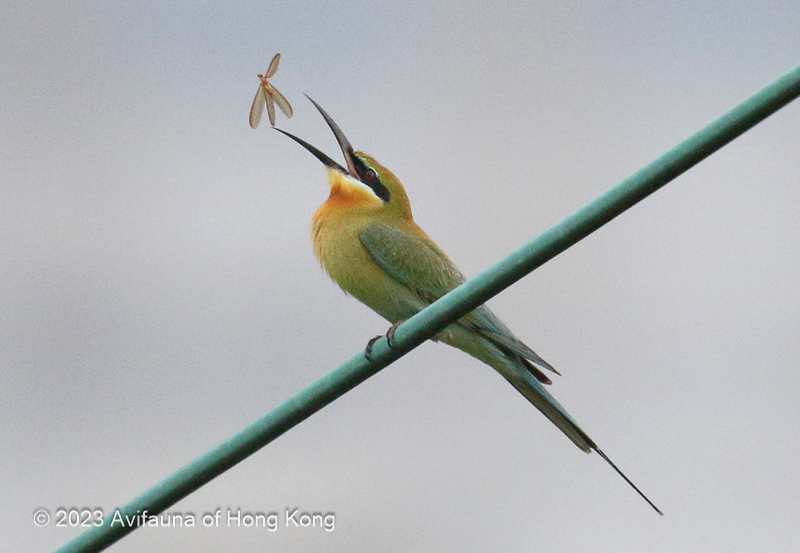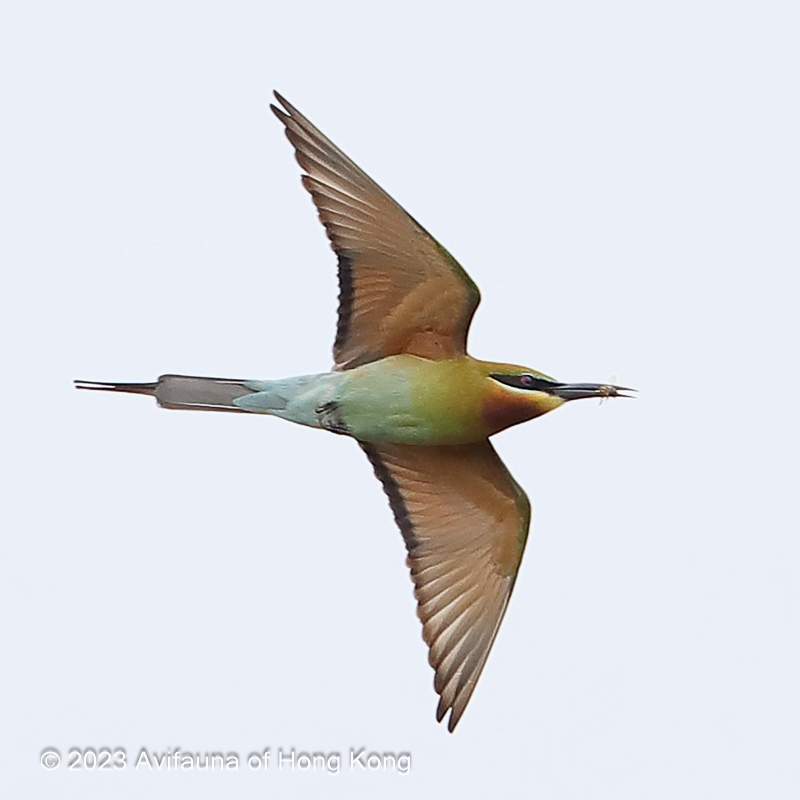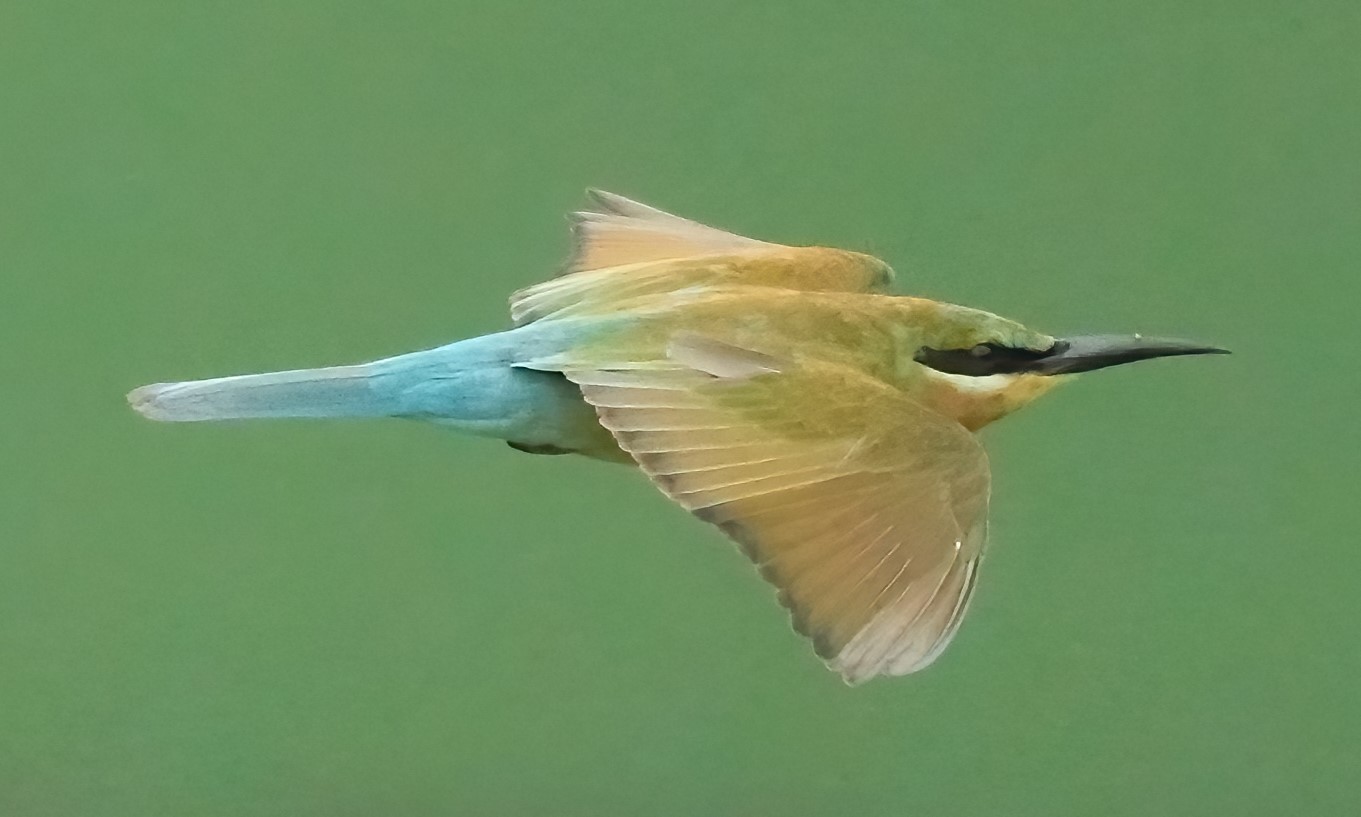BLUE-TAILED BEE-EATER Merops philippinus 栗喉蜂虎
Category I. Fairly common spring and autumn passage migrant to open country in variable numbers.
IDENTIFICATION

Apr. 2016, John and Jemi Holmes. Adult.
28–30 cm (with streamers, up to 7 cm more). A slim bird with a slender down-curved bill, long pointed wings and a long tail with tail projection. Sexes alike. Crown and mantle olive-green with a brownish wash; wings olive-green with a turquoise wash; tertials bluish; rump and tail blue; mask black; chin yellow; throat chestnut; breast, belly and undertail coverts greenish, the latter tinged with blue.

Apr 2017, Michelle and Peter Wong. Adult.
Underside of the wing rufous. Juvenile is duller than adult with fainter chestnut throat and no tail streamers.

Oct. 2023, Paul Leader. First-year.
The lack of tail streamers indicates this is a first-year.
VOCALISATIONS
Flocks of migrants are highly vocal, whether in flight or perched. Calls are rich and liquid, but occasionally harsh when birds are interacting
DISTRIBUTION & HABITAT PREFERENCE
Most records are of birds migrating over open, low-lying wetland areas in the northwest New Territories, particularly at Mai Po. Occasionally recorded at other locations such as Stanley, southwest Lantau, Tai O, Lamma, Cheung Chau, Tung Ping Chau and Po Toi. It is rare over urban areas but in 2016 eight were seen at Victoria Park on 14 April and seven were at Ho Man Tin the following day.
Birds have been reported roosting in the intertidal mangroves at Mai Po on several occasions; indeed, the highest single count on record consists of 121 (two flocks of 81 and 40) coming to roost there at dusk on 5 October 2007.
OCCURRENCE
An uncommon to common passage migrant in spring and autumn, Blue-tailed Bee-eater has occurred between 22 March and 30 May in spring and 25 September and 4 November in autumn. Main spring passage occurs from the second week of April to the first week of May, peaking in the second half of April. Main autumn passage is during the first half of October (Figure 1). Since 1999 numbers recorded in the two seasons have been very similar.
Following one at HK University campus in April 1955 (Macfarlane and Macdonald 1960), two at Yuen Long on 29 April 1956 (Walker 1958) and four at Mai Po on 19 April 1959, there were no further reports until 1979. Thereafter, it was recorded in seven years up to 1993 and annually since 1994. During the 1990s the highest annual estimate of individuals was 68 in 1995. Double-digit totals continued until 2007, in which year a then unprecedented 355 birds were recorded. Since 2009 however, all annual counts have been in triple digits, the highest being 421 in 2013, and the lowest 120 in 2011 (Figure 2). Although a rise in observer activity may play a part, the scale of increase suggests a genuine increase in the number passing through HK on migration.
On occasions visible migration may be very obvious, the largest such movement being 113 through Mai Po on the morning of 5 October 2020. Most birds pass through quickly, rarely lingering for more than an hour or two, if at all, but there are reports of birds remaining at the same site for two to three days, or occasionally longer; for example, five hunted from a stand of Acacia confusa at Mai Po during 20-21 April 1991, and 14 gathered at dusk – presumably to roost - at the same section of the security fence at Tsim Bei Tsui on 5th and 9 October 1994.
BEHAVIOUR, FORAGING & DIET
Migrating birds often pass over quite high in small parties and are often first detected by their contact calls. Some will regularly perch on service wires and bare trees to rest. Birds may feed on the wing or by pursuing aerial prey from lookout perches on trees, powerlines and telephone wires. Prey includes chironomids, dragonflies and bees.
SYSTEMATICS & RANGE
Monotypic. Blue-tailed Bee-eater is a breeding summer visitor to north and central India east through Indochina to southeast China. It winters in southern India, Sri Lanka and southeast Asia south to the Greater Sundas. Resident populations also occur in southern Sri Lanka, southeast Asia, the Philippines, and Sulawesi southeast to New Britain (Fry & Boesman 2020). In China, it is a breeding visitor to Hainan (Lewthwaite et al. 2021), Sichuan, Yunnan, Guangxi, coastal Guangdong (Liu and Chen 2020), south Fujian and Kinmen Island (Brazil 2009), though in HK it is only a passage migrant.
CONSERVATION STATUS
IUCN: Least Concern. Population trend stable.
Figure 1.

Figure 2.

Brazil, M. (2009). Birds of East Asia. Christopher Helm, London.
Fry, H. and P. F. D. Boesman (2020). Blue-tailed Bee-eater (Merops philippinus), version 1.0. In Birds of the World (J. del Hoyo, A. Elliott, J. Sargatal, D. A. Christie, and E. de Juana, Editors). Cornell Lab of Ornithology, Ithaca, NY, USA. https://doi.org/10.2173/bow.btbeat1.01
Lewthwaite, R. W., F. Li and B. P. L. Chan (2021). An annotated checklist of the birds of Hainan Island, China. J. Asian Ornith. 37: 6-28.
Lewthwaite, R. W., F. Li and B. P. L. Chan (2021b). Online Supplement to “An Annotated Checklist of the Birds of Hainan Island, China”. Available at https://www.kfbg.org/images/download/hainan-bird-checklist-supplement.pdf
Liu, Y. and Y. H. Chen (eds) (2020). The CNG Field Guide to the Birds of China (in Chinese). Hunan Science and Technology Publication House.
Macfarlane, A. M. and A. D. Macdonald (1960). An Annotated Check-list of the Birds of HK. South China Morning Post. HK.
Walker, F. J. (1958). Field Observations on birds in the Colony of HK. HK Bird Watching Society, HK. (duplicated).

